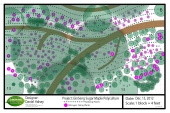Zach, there are many species of plants that are being pushed out by invasives. Without going into the full background, many people have embraced non-native species for food and medicine and have even glorified the presence of some ecologically damaging species (such as Fallopia japonica--Japanese knotweed). Clearly, the addition of a highly invasive species that dramatically alters the flora can be viewed as beneficial or detrimental, depending on who you are and your point of view. If you are seeking medicine for Lyme Disease, then Fallopia japonica is a wonderful plant to have on your landscape. If you are a
native species of plant that has been crowded out of existence at a
local site, Fallopia japonica isn't beneficial to you. My point--we tend to think in human-centric terms about what is good or bad (as far as changes). From a conservation point of view, Fallopia japonica is highly damaging (and, we already had Lyme Disease herbs present on our landscape here in North America). The first step is recognizing how much humans have altered the landscape (approximately 35% of our flora is now comprised of non-native species). Conservation efforts are hampered by the continual introduction of new non-natives due to global travel/trade. Being involved in local conservation organizations is one way to get abreast of the issues and learn how to contribute. Best wishes.





